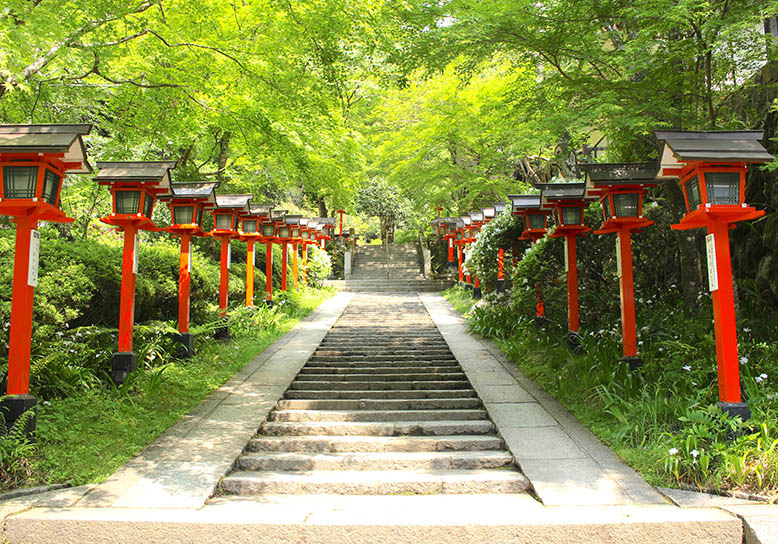Kurama-dera Temple
A Buddhist temple whose origin dates back to 770 when Gantei (Jiàn zhēng) shonin, the leading disciple of the Chinese priest Ganjin (Jiàn zhēn) wajyo, enshrined a statue of Bishamonten (Vaisravana: the guardian god of Buddhism) here. Thereafter, in 796, Chief of Temple Construction Fujiwara no Isendo had an additional temple building constructed here enshrining a figure of Senju Kannon (Thousand-armed Buddhist Goddess of Mercy). The temple is known for its legends regarding a tengu (long-nosed goblin) and Ushiwakamaru (young Minamoto no Yoshitsune), and there are sites along the mountain trail leading to the inner sanctuary from behind the main temple building connected to him. The “path of 99 bends,” which famed author and court lady Sei Shonagon described as being “short yet long” in her Pillow Book, extends for approximately one kilometer between the main temple gate and the main temple building, but visitors may also ride a cable car up to the temple’s two tier pagoda. A renowned “power spot,” this popular site is visited by great numbers of people each year.
Spot details
- Address
-
Kyoto Kyoutoshi Sakyou-ku Kuramahonchou 1074
Map
- Phone
- 0757412003
- Hours
- [Opening hours for worship]9:00-16:15
- Closed
- [Reihoden] Monday (The next day for public holidays)
- Fees
- [Aizan fee] [High school students and above] 300yen[Reihoden][Adult]200yen[Elementary and junior high school students]100yen
- Parking Lot
- Not available
- Credit Card
- Not available
- Smoking
- Not available
- Wi-Fi
- Not available
- Estimated stay time
- 60-120 minutes
- Wheelchair accessible
- Available
- Infant friendly
- Available
- Pet friendly
- Available
Information Sources: NAVITIME JAPAN
Articles about this spot
Itineraries about this spot
Review
-
- perfect hike
- Beautiful walk up the mountain. You pass shinto shrines, and Buddhist temples in which the priests chant the Heart Sutra, up to the main complex with beautiful view over the green valley. If you have...
-
- A worthy hike to the temple
- We visited Kurama temple in the afternoon after visiting Kifune shrine at the neighboring town. Kurama Temple is located at the base of the Mount Kurama but will still need to hike up to the temple...
-
- Beautiful mountain temple away from the crowds
- This beautiful mountain temple was something different than the ones in Kyoto city area. To begin with, it is clearly off the beaten track and hence a welcome getaway from the crowds. The temple area...
TripAdvisor Traveler Rating
View more






![[Kyoto / Ohara] Textile dyeing experience-Postcard dyeing ‘Kakishibu dyeing plan‘ Participation is OK from 6 years old ・ You can take it home on the On the day](https://img.activityjapan.com/10/14017/10000001401701_qWjfBjfX_4.jpg?version=1581475994)
![[Kyoto /Ohara] Textile dyeing experience ~ Tenugui tie dye ‘Kakishibu dye plan‘ OK from 5 years old OK to take home on the On the day!](https://img.activityjapan.com/10/14025/10000001402501_lWAdXOGn_4.png?version=1581476117)









